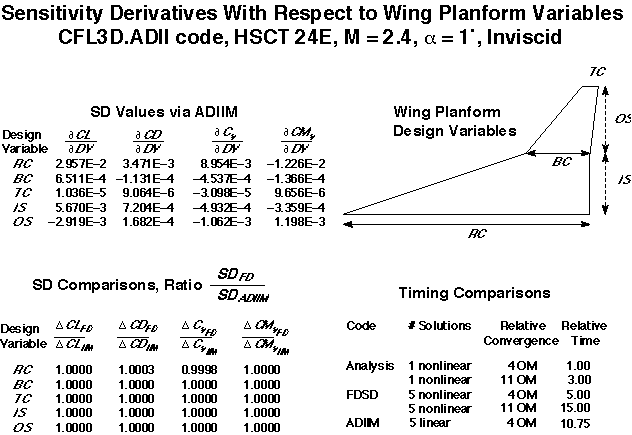NASA
High Performance Computing
and Communications Program
Computational AeroSciences Project
Automatic Differentiation of the CFL3D Flow Analysis Code in Incremental Iterative Form
Objective: The objective of this study is to implement an efficient methodology for computing accurate, discrete, geometric-shape, sensitivity derivatives (SDs) from the general-purpose flow-analysis code CFL3D.
Approach: In previous studies, the automatic differentiation (AD) software tool ADIFOR (AD of Fortran) has been shown to be a reliable approach for obtaining consistent discrete SDs accurately. However, to achieve satisfactory computational efficiency from the AD approach, the desired aerodynamic SDs must be computed using the incremental iterative method (IIM).
Accomplishments: The preceding approach has been successfully applied to create version 1.0 of the new general-purpose flow-analysis/flow-sensitivity-analysis code CFL3D.ADII (CFL3D Automatically Differentiated in Incremental Iterative form). All of the original flow-analysis code capability (except unsteady flow) has been retained in calculating the shape SDs. This includes: multiblock patched-grids and overlapped-grids for complex geometric shapes; 3D turbulent flow (with choice of six different turbulence models); choice of two spatially-split approximate factorization solution algorithms with multigrid acceleration for solving the SD equations; and many other features. The data input format of the original flow code has been retained, with the addition of only a few extra control parameters for generating the SDs; a short "user's manual" is available. The CFL3D.ADII code has been validated with respect to accuracy and computational efficiency on two example problems: (1) a single-block coarse grid for the transonic, high Reynolds number, turbulent 3D flow over an ONERA M6 wing; and (2) a dual-block, coarse grid for supersonic (M = 2.4, a= 1°) inviscid flow over an HSCT-type wing-body geometry. For the first example, the calculated SDs were shown to agree well with similar calculations obtained from a "black-box" application of AD, with computational efficiency improvement of approximately 30% resulting from the IIM implementation. For the second (inviscid) example, SD results for lift (CL), drag (CD), side force (Cy), and pitching moment (CMy) with respect to five wing planform design variables (DV) are presented in the tables on the attached Figure. The five DV are defined in the sketch at the upper right hand corner. Comparisons of computational accuracy and efficiency are made in these tables with corresponding SD results from the "brute force," one-sided, finite-difference approach. Two analysis code convergence levels are shown for the finite-difference sensitivity derivatives (FDSD) in the timing comparisons table at the lower right; the 11 OM (Orders of Magnitude residual reduction) results were used in the SD ratio comparisons shown at the lower left and produced SD agreement with the ADIIM results to about 4 significant figures. The ADIIM timing is equivalent to that for one-sided FDSD at about 8 OM or central finite-differences at 4 OM; i.e. ADIIM timing is about the same as that for finite differences, but ADIIM is more accurate.
Significance: The first version of a general-purpose flow-analysis/flow-sensitivity analysis code CFL3D.ADII has been successfully developed and validated. The code can be applied by others within a multidisciplinary design environment.
Status/Plans: Key changes have been identified that should significantly improve the efficiency of the CFL3D.ADII code; a committed effort is underway to develop and implement a parallelized version of the code (workstation clusters or the IBM SP2).
A. C. Taylor III & A. Oloso
Old Dominion University
(757) 683-3739
email : taylor@mem.odu.edu
L. L. Green & P. A. Newman
NASA Langley Research Center
(757) 864-2228/864-2247
email : l.l.green@larc.nasa.gov
p.a.newman@larc.nasa.gov
